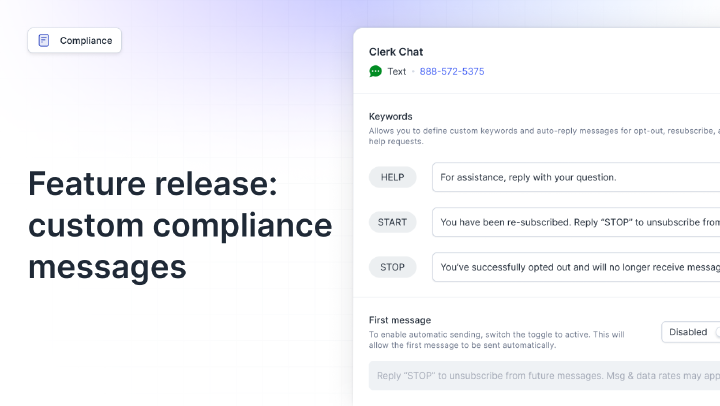How to Improve Response Time to Customer: 7 Steps to Faster Support
By Team Clerk Chat
- Published: November 28, 2024
If you want to improve your brand’s reputation, retain more customers, and differentiate yourself from the competition in today’s competitive world, you need to learn how to improve response times to customer requests. After all, success in any industry today relies on your ability to deliver a consistently excellent experience to your target audience.
While there are numerous things that can influence the quality of the experience consumers get from you, and how satisfied they are with your business, speed is a crucial factor.
In fact, 90% of customers say an “immediate” response is crucial when they contact a company with a question or an issue they need to resolve.
If your company is slow to respond to queries about products or services, you don’t just risk losing sales, you could end up actively sending customers into the arms of your competitors.
Fortunately, there are ways to improve your customer service response time and delight your audience with more efficient, consistent support.
Deliver the instant support your customers crave.
Clerk Chat makes it easy to improve response times.
What is Customer Service Response Time?
Customer service response time is essentially the time it takes for your customer support, sales, or technical help staff to respond to a customer query. Most commonly, companies measure something called “First Response Time” (or FRT) for insights into how rapidly they’re addressing customer concerns. This means measuring how long it takes to respond to the first request made by a customer.
In recent years, learning how to improve “response time to customer” or FRT has become increasingly important for businesses in every industry. That’s because customer expectations have evolved. According to Zendesk, customers now expect companies to be faster at responding to their questions than ever before.
On some channels, like live chat, social media, and phone calls, your customers might even expect you to respond to a query almost immediately. Even if your customers contact you via “slower” communication methods, like email, they still expect responses in less than 12 hours.
Why is a Good First Response Time Important?
Ultimately, customers judge the quality of the service your company gives based on various factors, including how personalized and useful the support is, and how easy it is to reach your company on the channels they prefer to use, like email or SMS.
How quickly you respond to requests has a direct impact on how satisfied your customers will be with the level of support you offer and how loyal they’ll be to your business. If your customers can’t get answers from your team quickly whenever they have an issue, they’ll abandon your organization in favor of a speedier competitor.
Learning how to improve response times to customer requests doesn’t just ensure you can adhere to customer expectations, and reduce your risk of losing customers either.
A better customer response time also:
- Prevents lost leads: Customers won’t just contact your team when they have an issue with your product or service that they need to address. They might also contact you with questions about your solutions. If you fail to respond quickly, they could end up searching for alternatives and purchasing a competing solution, meaning you miss out on sales.
- Improves business efficiency: If your customer service team takes too long to respond to a customer via email, they could end up reaching out over other channels like SMS, live chat, or social media. This creates more of a workload for team members who need to go back and confirm a support ticket originally created for one channel has been resolved elsewhere.
- Protects your reputation: Poor response times send a message to your customers that you’re not prioritizing their needs and experiences. It could also lead to customers leaving negative reviews about your business online, which makes it harder to earn the trust of future leads. Alternatively, a fast response time can enhance your reputation and make your company more appealing to future customers, increasing your chances of long-term success.
Calculating and Measuring First Response Time
To improve your customer response times, you first need an idea of how quickly you’re responding to customer requests and queries already. Calculating first response time (FTR) is usually pretty straightforward, particularly if you’re using customer service technology, like an SMS customer service platform that monitors response rates.
All you really need to do is divide the total first reply time for all of your agents by the total number of resolved “issues” or tickets in a certain period.
Beyond that, there are a few specific ways to measure FRT:
- Define FRT in the scope of business hours: Unless you have a huge customer service team, there will likely be times when your employees aren’t available to respond to requests. You generally shouldn’t include “off hours” in your calculation when you’re calculating first response times, because this can lead to confusion.
- Focus on the “median” response time: Response times can vary based on the complexity of the issues or the nature of the request. Calculating a “median” response time allows you to control for different factors that might influence your results.
- Track FTR in your customer service reports: Customer service reports generally combine numerous key performance indicators that help you to get a comprehensive overview of how you’re managing customer experiences. You can create customer service reports with software and use automatic tools to calculate FTR consistently.
How to Improve Response Time to Customer: 7 Ways
If, after analyzing average response times for your teams, you discover you’re not responding to customers as quickly as you’d like, there are steps you can take to improve your results. Here are some of the most effective ways to accelerate customer service.
1. Use SMS for Customer Service
By far, one of the best ways to ensure you can respond to customer queries quickly and consistently is to invest in SMS. Text messaging isn’t just a great way to keep in touch with your customers, and rapidly share information about your latest products and services.
Deliver the instant support your customers crave.
Clerk Chat makes it easy to improve response times.
It can also be a fantastic way to deliver fast-paced support and customer service. With SMS, you benefit from excellent deliverability rates, (SMS deliverability rates can be even higher than those of email), so customers are less likely to miss your responses.
Plus, if you’re using a comprehensive platform like Clerk Chat, your team will be able to take advantage of a convenient, unified phone number where they can track every message in real time, prioritize crucial conversations based on urgency, and even use automated text messages or AI to respond to customer queries in an instant.
Plus, SMS is a naturally fast-paced way to communicate with customers. It only takes a couple of seconds to formulate a response to a question, particularly with tools like canned responses and SMS templates, meaning you can respond to more queries in a shorter space of time.
2. Become Truly Omnichannel
Implementing SMS as a support channel is a great way to improve your customer response time. However, it’s worth remembering that although SMS is a popular way to communicate, it’s not going to be the preferred option for every customer.
You may still need to offer access to other channels too, such as social media, email, and even phone calls or video conferencing sessions. The key to making sure your use of various channels for customer service improves customer experiences, rather than creating more complexity, is making sure all of those channels are connected.
For instance, make sure your workflow SMS tools can seamlessly integrate with the tools you use to manage support requests on other platforms. Make sure your teams and customers can easily move from one channel to another without losing data or context.
For instance, if your customer contacts you initially via SMS, then decides to request a call, they should be able to do so without having to repeat themselves.
3. Enable Self-Service Options
When you’re embracing omnichannel solutions to improve first response time for your customers, don’t forget to think about self-service options. Having a self-service knowledge base available on your website or investing in AI-powered text messaging solutions and chat bots can speed up response times in various ways.
First, they ensure that customers have an instant way to access a response to a question or query, even when human agents may not be available to address their issue. Customers won’t have to sit around waiting for someone to respond to an email if they can just find an answer to their problem by visiting your website or talking to a bot.
Secondly, implementing self-service solutions reduces the number of queries your human agents actually have to deal with. When customers can resolve most of their common issues alone, the number of support requests your agents need to handle will drop. This means they should be able to move through call queues and deal with requests a lot faster.


4. Leverage AI and Automation Technologies
AI and automation solutions don’t just help to improve customer response times by giving consumers access to more intuitive self-service solutions. They can also help to make your customer service teams more efficient and productive.
For instance, Clerk Chat’s AI Assistant can surface information instantly about a customer and their purchasing history and suggest responses to questions, saving agents time searching for relevant solutions to problems.
Automation solutions can also give agents access to “canned responses” and templates that save them time actually typing out responses to common inquiries. Even if your employees are using a personal phone for work or dealing with support requests from a platform like Microsoft Teams, they can tap into a tool like Clerk Chat to immediately access canned responses and templates.
Plus, they can automate other processes too, like following up with a customer after an issue has been resolved to check they were happy with the service. You could even use automation to proactively message customers about technical issues or give them access to troubleshooting guides.
5. Organize Support Requests and Tickets
Sometimes, dealing with requests one-by-one, as they arrive, won’t be the best way to deliver exceptional customer service. Customer responses often vary in terms of urgency. For instance, you wouldn’t necessarily need to respond to a customer’s questions about SMS opt-in & opt-out policies within minutes, provided you share enough information on your lead capture forms.
However, you may need to prioritize addressing a request that could lead to a sale, or dealing with a serious technical issue or fault. Using a “ticketing” system, or platform that integrates with the channels you use for customer service, your tools for archiving text messages and conversations, and even your collaboration platforms, will help you organize requests more effectively.
The right Helpdesk Software will allow you to create rules for how messages and requests should be prioritized, based on things like urgency or the value of the customer. Some solutions can even automatically assign tickets to different team members based on their skills and workload. This all helps you to streamline customer support strategies.
6. Create Response Time Policies
One of the best ways to improve first response time and your company’s reputation is to set clear benchmarks for your employees to adhere to. Just as you have policies in place that might show staff members how to adhere to SMS regulations and handle marketing strategies, you can also create policies that show teams what they should be aiming for when responding to customer requests.
Based on what you know about your current response times and the benchmarks in your industry, establish a clear “target” response time for every communication channel. For instance, you may ask all employees to make sure they respond to texts within 2 hours, calls within 10 minutes, and emails within 12 hours.
Your help desk and customer service software should be able to automatically track how well you’re adhering to those benchmarks, so you can identify where you need to make improvements. Ultimately, having policies in place ensures all of your staff members are on the same page about how quickly they should be dealing with support requests.
It can also be a good way to identify which of your team members need more training and support to help them improve their performance.
7. Support Your Team
Finally, even the best customer service teams can only accomplish so much without the right support. Your employees need a combination of technology and training to achieve the best results when delivering customer service.
Make sure your teams know how to use the channels you offer for customer support effectively. Provide them with guides on how to send text messages from MS Teams or use pre-written, reusable responses. Make sure they know how to navigate common problems when delivering support.
For instance, if your employees use their own phones at work, they should know how to text from a different number (your business number), without switching devices or SIM cards.
Additionally, ensure that your employees have all of the resources they need to answer questions quickly. They should have direct access to a knowledge base they can use to surface information about products and services and troubleshoot potential issues.
The more support and guidance you give your teams, the more effective they’ll be at delivering excellent customer experience across channels.
Improve Customer Response Times with Clerk Chat
Although there’s definitely more to providing customers with an excellent experience than prioritizing speed, it’s important to ensure you can live up to customer expectations. Learning how to improve response times to customer requests with the right technology, training, and processes can significantly enhance your brand’s reputation, increase customer loyalty, and reduce churn.
With Clerk Chat, it’s easy to take your customer support strategy to the next level, with an intuitive solution for SMS-focused customer service. Our simple and intuitive platform makes it easy to communicate quickly with thousands of customers through the channel they like best.
Plus, with our AI assistant, you can even automate self-service for your customers, reducing the number of queries your agents need to handle each day. Discover how you can improve customer response times with an SMS-first approach. Contact Clerk Chat today.
In this article:
Ready to use your business number for text messaging?
Thousands of businesses are already experiencing the power of conversational messaging through SMS. Join us. Free trial and paid tiers available.
Get Started#Subscribe
Get product updates in your inbox
Tutorials, features, and Clerk Chat news delivered straight to you.




